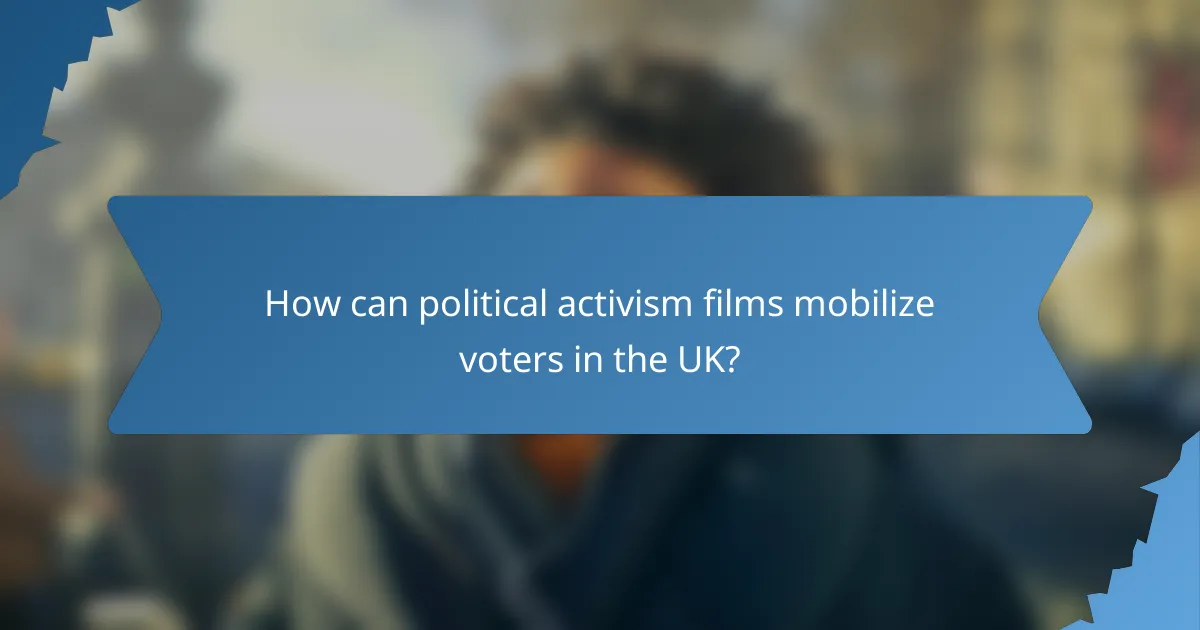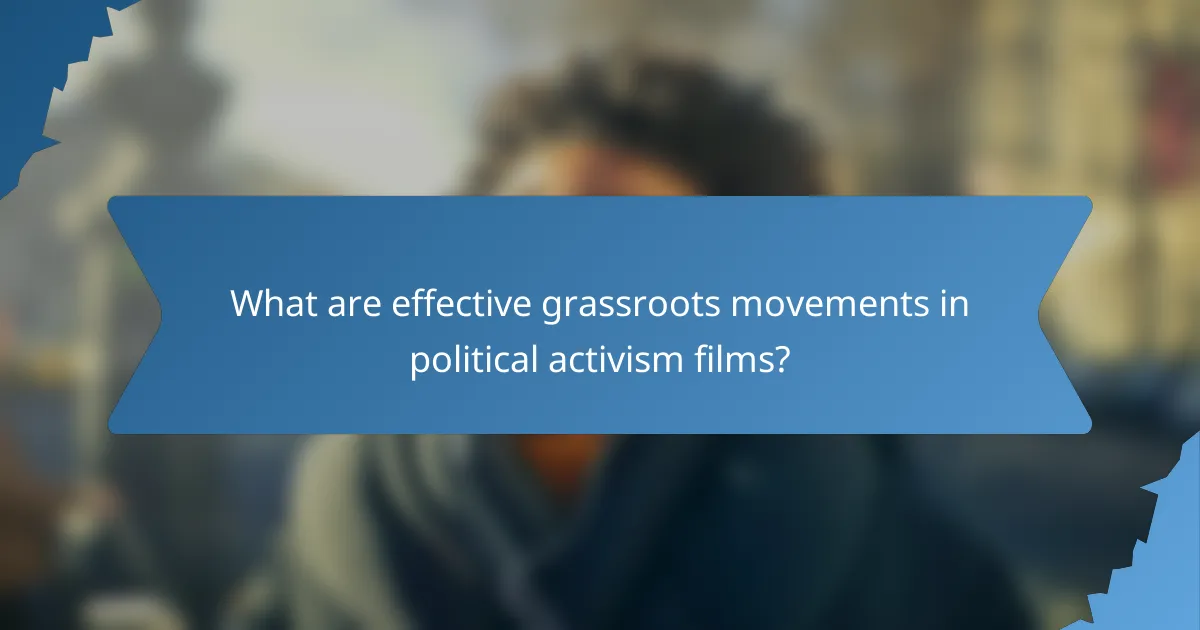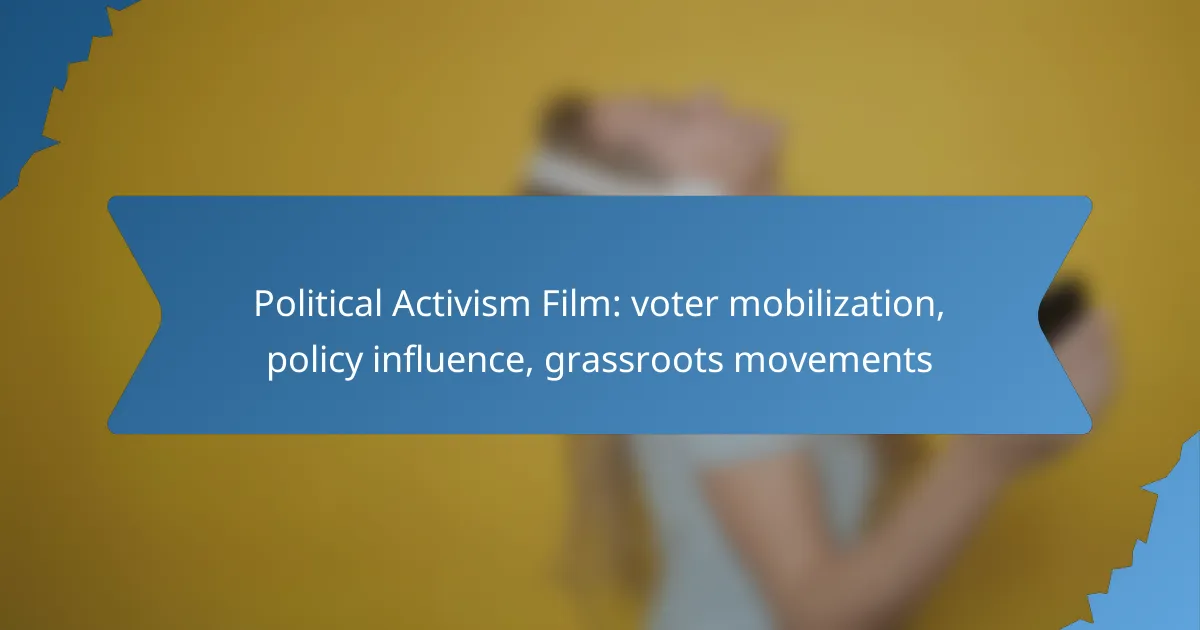Political activism films play a crucial role in mobilizing voters by highlighting pressing social issues and inspiring collective action. Through compelling storytelling, these films not only inform audiences but also encourage them to engage in the democratic process, influencing policy and fostering grassroots movements. By showcasing the power of community engagement, they demonstrate how ordinary individuals can drive significant social change.

How can political activism films mobilize voters in the UK?
Political activism films can effectively mobilize voters in the UK by raising awareness of critical issues and inspiring action through compelling narratives. These films not only inform viewers but also encourage them to participate in the democratic process, influencing policy and grassroots movements.
Engaging storytelling techniques
Engaging storytelling techniques are essential for capturing the audience’s attention and conveying complex political messages. Films that use personal stories or relatable characters can create emotional connections, making viewers more likely to empathize with the issues presented.
For example, documentaries that follow individuals affected by specific policies can illustrate the real-life implications of political decisions. This approach not only informs but also motivates viewers to take action, whether by voting or joining advocacy groups.
Highlighting key issues
Highlighting key issues is crucial for directing public attention to topics that may otherwise be overlooked. Political activism films often focus on pressing matters such as climate change, social justice, and electoral reform, presenting them in a way that resonates with the audience.
By framing these issues within the context of personal stories or urgent calls to action, filmmakers can galvanize viewers to engage with the political landscape. This can lead to increased voter turnout, especially among younger demographics who may feel disconnected from traditional political discourse.
Utilizing social media platforms
Utilizing social media platforms amplifies the reach of political activism films, allowing them to engage a broader audience. Platforms like Twitter, Facebook, and Instagram enable filmmakers to share clips, trailers, and behind-the-scenes content, sparking conversations around the issues presented in their films.
Moreover, social media can facilitate community-building among viewers, encouraging them to discuss the film’s themes and organize events. This digital engagement can translate into real-world activism, driving voter mobilization efforts and fostering grassroots movements across the UK.

What are effective grassroots movements in political activism films?
Effective grassroots movements in political activism films are organized efforts by ordinary people to influence policy and mobilize voters. These movements often highlight the power of collective action and community engagement to drive social change.
Case studies of successful movements
One notable example is the “Fight for $15” campaign, which advocates for a $15 minimum wage in the United States. This movement successfully mobilized fast-food workers and garnered widespread public support, leading to significant policy changes in various cities and states.
Another example is the “March for Our Lives,” initiated by students after the tragic shooting at Marjory Stoneman Douglas High School in Florida. This movement effectively raised awareness about gun control and mobilized young voters, influencing legislative discussions across the country.
Community engagement strategies
Successful grassroots movements often utilize door-to-door canvassing to connect with community members directly. This personal approach fosters relationships and encourages participation in local initiatives.
Social media campaigns are also crucial for grassroots engagement. Platforms like Twitter and Instagram allow movements to reach a broader audience quickly, share compelling narratives, and mobilize supporters for events and actions.
Additionally, hosting community events, such as town halls or workshops, can effectively educate and involve citizens in the political process. These gatherings create a space for dialogue, allowing participants to voice their concerns and collaborate on solutions.

How do political activism films influence policy?
Political activism films influence policy by raising awareness, shaping public opinion, and mobilizing grassroots movements. These films often highlight social issues, encouraging viewers to engage with policymakers and advocate for change.
Documenting real-life impacts
Political activism films serve as powerful tools for documenting real-life impacts of policies and social issues. By showcasing personal stories and community struggles, these films can humanize abstract concepts, making them relatable and urgent for audiences. For instance, films that depict the effects of climate change on local communities can galvanize public support for environmental policies.
Moreover, these documentaries often provide evidence that can be used in advocacy campaigns, demonstrating the need for legislative changes. By presenting factual data alongside personal narratives, filmmakers can effectively illustrate the consequences of inaction, thus influencing policymakers to consider reforms.
Collaborating with policymakers
Collaboration between filmmakers and policymakers can enhance the effectiveness of political activism films. When filmmakers engage with lawmakers during the production process, they can ensure that the film accurately reflects the complexities of the issues at hand. This partnership can lead to more informed discussions and potential policy changes based on the film’s findings.
Additionally, screenings of these films can serve as platforms for dialogue between the public and policymakers. Organizing events where lawmakers attend film screenings can facilitate discussions about proposed legislation, allowing audiences to voice their concerns and suggestions directly to decision-makers.

What role do documentaries play in voter mobilization?
Documentaries serve as powerful tools for voter mobilization by highlighting critical issues, educating the public about voting rights, and inspiring action. They can effectively influence public opinion and encourage grassroots movements aimed at increasing voter turnout and participation.
Raising awareness about voting rights
Documentaries can shine a light on the historical and ongoing struggles for voting rights, making complex issues accessible to a broad audience. By showcasing personal stories and systemic challenges, these films can foster a deeper understanding of why voting rights matter.
For example, films that document voter suppression tactics can motivate viewers to advocate for policy changes. This awareness can lead to increased public pressure on lawmakers to protect and expand voting access, particularly in regions with restrictive laws.
Encouraging civic participation
Documentaries often include calls to action, urging viewers to get involved in civic activities such as registering to vote or participating in local elections. By presenting relatable narratives, these films can inspire individuals to take personal responsibility for their civic duties.
Additionally, many documentaries provide information on how to register, where to vote, and the importance of local elections. This practical guidance helps demystify the voting process, making it easier for people to engage and participate actively in their democracy.

What are the challenges faced by political activism films?
Political activism films encounter several challenges that can hinder their effectiveness in voter mobilization and policy influence. Key issues include securing funding and distribution, as well as striking a balance between entertainment value and the seriousness of activism.
Funding and distribution issues
Securing funding for political activism films often proves difficult due to the niche nature of their content. Many investors prefer projects with broader commercial appeal, which can limit financial support for films focused on specific social issues.
Distribution is another significant hurdle. Activism films may struggle to find platforms willing to showcase their work, especially if the content challenges mainstream narratives. Independent film festivals and online streaming services can be viable alternatives, but they may not reach as wide an audience as traditional cinema.
Balancing entertainment and activism
Political activism films must balance engaging storytelling with the seriousness of their message. A film that is too didactic may alienate viewers, while one that prioritizes entertainment might dilute its political message.
Filmmakers should aim to create narratives that resonate emotionally with audiences while still delivering a clear call to action. Using relatable characters and compelling plots can help bridge the gap between entertainment and activism, making the film both enjoyable and impactful.

How can filmmakers measure the impact of their work?
Filmmakers can measure the impact of their work through various metrics that gauge audience engagement, voter turnout, and policy influence. By analyzing these factors, they can assess how effectively their films mobilize viewers and contribute to grassroots movements.
Audience engagement metrics
Audience engagement metrics include views, shares, comments, and social media interactions. These indicators help filmmakers understand how well their content resonates with viewers and encourages them to take action. For example, a film that generates high social media shares may indicate strong viewer interest and potential for mobilization.
Filmmakers can also track engagement through surveys and feedback forms, asking viewers about their motivations and actions taken after watching the film. This qualitative data can provide deeper insights into the film’s influence on audience attitudes and behaviors.
Voter turnout statistics
Voter turnout statistics are crucial for assessing the effectiveness of a film in mobilizing voters. By comparing turnout rates in areas where the film was screened to those where it was not, filmmakers can gauge the film’s impact on electoral participation. Typically, successful voter mobilization efforts can lead to increases in turnout by several percentage points.
Additionally, filmmakers should consider collaborating with local organizations to track changes in voter registration and participation following screenings. This partnership can provide valuable data and enhance the film’s credibility in influencing policy and grassroots movements.
